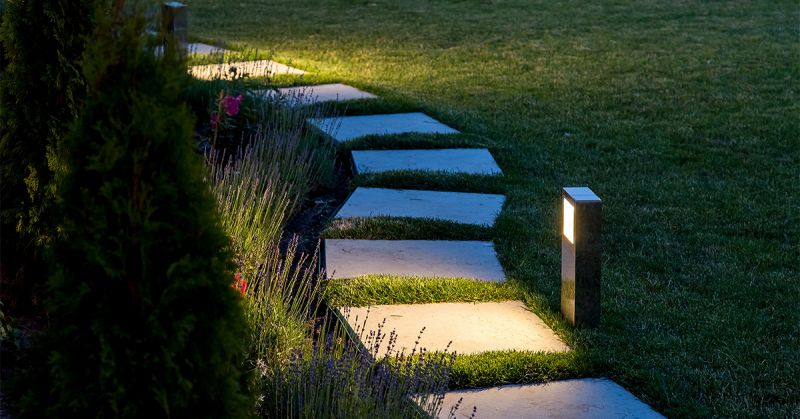
Choosing the Right Type of Landscape Lighting
Outdoor residential lighting has come a long way since your grandparents’ youth. Fifty years ago, most Tallahassee-area homes illuminated their outdoor spaces with front and back door lights. Some used porch lights, and perhaps a floodlight or spotlight for the driveway. Back then, lighting was primarily used for security purposes. To help people safely navigate their way around the exterior of their house at night. Presently, there is a much wider variety of outdoor and landscape lighting to choose from. People have discovered that outdoor lighting adds a nighttime design element to their yards and homes.
With almost 50 years of providing electrical services to the Tallahassee area, the electrical experts at Meeks Electrical Services know a thing or two about outdoor and landscape lighting trends. Read on to learn their take on landscape lighting types, placement, and design.
Types of Landscape Lighting for Your Tallahassee Home
Your choice of landscape lighting options will typically depend upon its purpose, whether safety, security, aesthetics, or a combination thereof. The following landscape lighting options can meet all your outdoor lighting needs and aesthetic desires:
Floodlights—with a 120-degree light spread, floodlights cover a lot of ground, making them the perfect option for security or illuminating large sections of your yard during nighttime events. Consider connecting them to a motion sensor if using them primarily for security purposes.
Spotlights—this lighting option focuses a narrow, concentrated beam of light on a small area. As such, they aesthetically highlight any outdoor or architectural features. For safety and security purposes, they can focus light on specific areas. Auxiliary entranceways, areas with valuable property, or potentially hazardous areas, such as uneven ground or steps. Depending upon primary usage, a motion sensor may pair well with one.
Post lights—This style of lighting is set on a post to brighten any area of the yard that gets too lost in the dark of night for your liking. They come in a wide variety of styles and typically produce just enough light to navigate the otherwise darkened area.
Deck Lights—if you have an outside deck, various deck light options can light up your entertaining space and illuminate deck stairs for safety. You have a wide choice of ambiance you can create with deck lighting. It can be installed directly on the deck itself or surrounding hardscape, and you can choose from a wide range of illuminations.
Pathway Lights—these lights can enhance safety on walkways and paths or ambiently illuminate hard-to-see yard features such as flowerbeds.
Well Lights—similar to pathway lights, this inground form of lighting provides a sophisticated means of illuminating walkways, driveways, flowerbeds, trees, as well as other outdoor features. The up-lighting effect puts the focus on the lighting rather than the light fixture.
Bollard Lights—another option for pathways, driveways, garden beds, and other outdoor features needing illumination, affix this low-level lighting to small posts that can line up to illuminate any area.
Post Cap Lights—typically used with low-glow illumination and affixed to deck posts, this decorative form of lighting creates a warm ambiance to your outdoor entertainment areas.
Underwater Lights—if you have a garden pond or swimming pool, underwater lights provide a shimmering highlight to them.
Hardscape Lights—installed on any hardscape, these small lights cast a grazing or washing spread of light across walls or other outdoor features you want to highlight artistically.
Focus on Effective Landscape Lighting Placement for Design
Effective outdoor lighting for safety and security purposes is straightforward because features that need to be illuminated are relatively obvious. Landscape lighting for aesthetics is a bit trickier, so we’ll review some techniques that capture the nighttime ambiance desired:
Up-Lighting—often achieved with spotlights, up-lighting involves shining ground-level lighting upwards to illuminate tall structures and trees dramatically.
Silhouetting—achieve this effect by placing spotlights or well lights behind objects or plants that aren’t all that noticeable in daylight. The hidden light silhouettes the plant or object for a dramatic effect.
Moonlighting—as the name implies, this technique replicates moonlight. It works by shining a soft-light spotlight mounted high in a tree or other object above the foliage.
Accenting—by using a narrow spotlight from a concealed position, you can dramatically highlight specific features of the yard.
Shadowing—somewhat opposite of silhouetting. This technique puts a hidden light in front of an object or plant in order to cast its shadow on a wall or other flat surface behind it.
Washing—this design illuminates large surfaces, such as a wall or hedge. It illuminates by shining a floodlight at them from an indirect angle. The effect creates soft, even lighting for the adjacent area.
Grazing—with this technique, you use spotlights, well lights, or hardscape lights adjacent to a wall or other flat surface to highlight its texture and create an interplay between the light and shadowing.
Contact Meeks for Your Landscape Lighting Installation
If you want to upgrade your yard’s nighttime aesthetics, safety, and security, call us! The experts at Meeks Electrical Services offer landscape lighting installation among its many services. For all your Tallahassee-area residential and business electrical needs, contact Meeks today at (850) 575-5241.